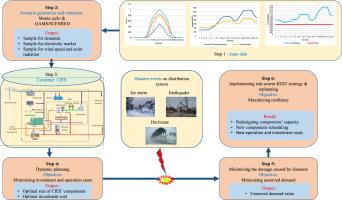用于增强社区一体化能源系统复原力的三层随机-IGDT 混合动态规划模型
IF 10.5
1区 工程技术
Q1 CONSTRUCTION & BUILDING TECHNOLOGY
引用次数: 0
摘要
本文开发了一个以复原力为导向的动态规划框架,用于优化社区综合能源系统组件的大小,包括光伏系统、风力涡轮机、锅炉、煤改电技术、热电联产和存储设备。所提出的框架是一个三级线性编程,在第一级执行正常条件下的社区综合能源系统设计,在第二级评估灾难性条件下的系统运行。在第三层,根据信息差距决策理论进行重新规划,以增强社区综合能源系统抵御各种自然灾害的能力。此外,还在各个层面采用随机程序设计,以应对电力市场价格、能源需求、太阳辐射和风速的不确定性。设计了一个详细的 P2G 系统,包括甲烷化装置、电解和氢存储,以提高系统的复原力。此外,该模型中提出的电能转化为燃气与碳捕集装置相结合,通过重新利用锅炉和热电联产烟气中排放的碳,减少碳排放。此外,还考虑了各种经济指标和技术限制,以实现切合实际的设计。数值模拟结果表明,可再生能源和储能技术(特别是 P2G)的积极相互作用有助于 CIES 在极端事件期间保持稳定和不间断的能源供应。结果表明,只需增加 10% 的弹性预算,就能减少 93% 的未服务需求,并有助于减少 37% 的碳排放。本文章由计算机程序翻译,如有差异,请以英文原文为准。

A tri-level hybrid stochastic-IGDT dynamic planning model for resilience enhancement of community-integrated energy systems
In this paper, a resilience-oriented dynamic planning framework is developed for optimal sizing of the community-integrated energy system components, including photovoltaic system, wind turbine, boiler, power to gas technology, combined heat and power, and storage devices. The proposed framework is formulated as a tri-level linear programming that performs Community-Integrated Energy Systems design under normal conditions at the first level while evaluating system operation during disastrous conditions at the second level. In the third level, re-planning is done based on information-gap decision theory to enhance community-integrated energy systems’ resilience against various natural disasters. Stochastic programming is also employed at all levels to address the uncertainty of electricity market price, energy demand, solar radiation, and wind speed. A detailed P2G system including, a methanation device, electrolysis, and hydrogen storage is designed to improve the resilience of the system. In addition, the power to gas proposed in this model is coupled with a carbon capture unit to mitigate carbon emission by reusing emitted carbon from the flue gas of the boiler and combined heat and power. Various economic metrics and technical constraints are also considered to achieve a realistic design. Numerical simulation results demonstrate that the positive interplay of renewable energy resources and energy storage technologies, specifically P2G, assisted the CIES in maintaining a stable and uninterrupted energy supply during extreme events. The results exhibit that increasing only 10 % of the resilience budget can decrease >93 % of unserved demand and helps reduction of >37 % of carbon emissions.
求助全文
通过发布文献求助,成功后即可免费获取论文全文。
去求助
来源期刊

Sustainable Cities and Society
Social Sciences-Geography, Planning and Development
CiteScore
22.00
自引率
13.70%
发文量
810
审稿时长
27 days
期刊介绍:
Sustainable Cities and Society (SCS) is an international journal that focuses on fundamental and applied research to promote environmentally sustainable and socially resilient cities. The journal welcomes cross-cutting, multi-disciplinary research in various areas, including:
1. Smart cities and resilient environments;
2. Alternative/clean energy sources, energy distribution, distributed energy generation, and energy demand reduction/management;
3. Monitoring and improving air quality in built environment and cities (e.g., healthy built environment and air quality management);
4. Energy efficient, low/zero carbon, and green buildings/communities;
5. Climate change mitigation and adaptation in urban environments;
6. Green infrastructure and BMPs;
7. Environmental Footprint accounting and management;
8. Urban agriculture and forestry;
9. ICT, smart grid and intelligent infrastructure;
10. Urban design/planning, regulations, legislation, certification, economics, and policy;
11. Social aspects, impacts and resiliency of cities;
12. Behavior monitoring, analysis and change within urban communities;
13. Health monitoring and improvement;
14. Nexus issues related to sustainable cities and societies;
15. Smart city governance;
16. Decision Support Systems for trade-off and uncertainty analysis for improved management of cities and society;
17. Big data, machine learning, and artificial intelligence applications and case studies;
18. Critical infrastructure protection, including security, privacy, forensics, and reliability issues of cyber-physical systems.
19. Water footprint reduction and urban water distribution, harvesting, treatment, reuse and management;
20. Waste reduction and recycling;
21. Wastewater collection, treatment and recycling;
22. Smart, clean and healthy transportation systems and infrastructure;
 求助内容:
求助内容: 应助结果提醒方式:
应助结果提醒方式:


